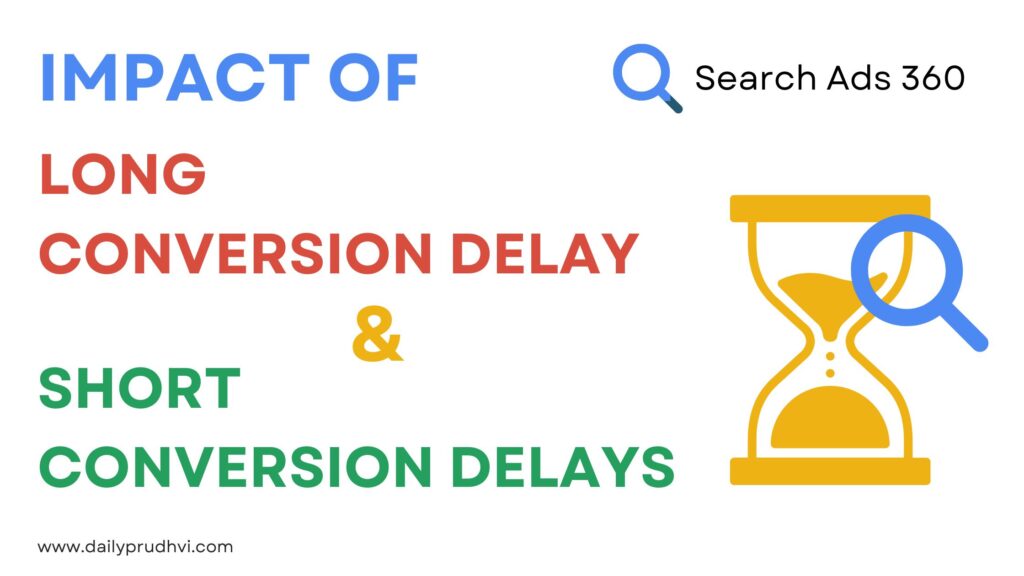Conversion delay refers to the time it takes for a significant portion of your conversions (e.g., 80%) to occur after a user clicks on an ad or engages with your content. In other words, it’s the time span between when someone interacts with your online marketing efforts (such as clicking an ad) and when they finally take a desired action (conversion), such as making a purchase, signing up, or filling out a form.

Lets take an example, if you run a campaign and find that 80% of your conversions happen within 7 days of a user clicking your ad, then the conversion delay for your campaign is 7 days.
This metric is useful in digital marketing because it helps businesses understand how long they should expect to wait before seeing most of the results from their ads. It also helps with optimizing the timing of campaigns and analyzing the effectiveness of ads over time.
Lets understand what is a conversion, what is conversion delay, why 80% and how conversion delay affects ad campaigns. We’ll also see one example of conversion delay, impact of conversion delays and will see how we can track the conversions.
- What is a conversion
- What is conversion delay
- Why 80%
- How conversion delay affects ad campaigns.
- One example of conversion delay
- Impact of conversion delays
- Conversion Tracking tools
- What is a Conversion?
A conversion happens when a user completes a desired action after interacting with your ad or website. This can be anything from making a purchase, signing up for a newsletter, downloading an app, or any other goal you’ve set for your marketing campaign.
- What is Conversion Delay?
The conversion delay is the amount of time between when a user interacts with your ad (usually by clicking it) and when they complete that desired action (conversion). The key point is that conversions don’t always happen immediately after a click. Some users may take time to make a decision—whether that’s a few hours, days, or even weeks.
For reporting purposes, Digital marketers often track how long it takes for 80% of all conversions to happen. This threshold (80%) is used to get a strong representation of user behavior without waiting for every single conversion, which can drag on too long or become less representative of overall trends.
- Why 80%?
While all conversions are important, 80% is considered a significant sample size to understand the general conversion behavior. Waiting for all conversions (100%) can take a long time and may not accurately reflect the majority’s behavior. The 80% figure is a practical balance between speed and accuracy.
- How Conversion Delay Affects Your Campaigns
Budget Optimization: Understanding the delay helps you plan how much time to wait before analyzing a campaign’s performance.
If your conversion delay is 5 days, you shouldn’t expect to fully evaluate the effectiveness of your campaign immediately after launching. Knowing the delay prevents premature decisions, like stopping a campaign too early.
Campaign Adjustment: If you know that users take a week to convert after clicking an ad, you may want to retarget them within that period to encourage conversion.
Customer Journey Insight: A longer delay might indicate a complex decision-making process, while a shorter delay may suggest immediate buying intent. This can guide you in tailoring your marketing messages.
- Example of Conversion Delay
Imagine you’re running an e-commerce site. You launch a Google Ads campaign for a product. People click your ad and visit your website, but only a portion of them buy right away. The rest might take time to compare prices, read reviews, or think about the purchase.
Day 1: 20% of people make a purchase right after clicking the ad.
Day 3: An additional 30% of users convert after some consideration.
Day 5: Another 30% of users buy your product.
Day 7: By now, 80% of the conversions from the initial click have happened.
In this case, your conversion delay is 7 days because it took that long for 80% of your conversions to occur after the initial click.
- Conversion Tracking Tools
You can track conversion delays using analytics platforms like Google Analytics or Facebook Ads Manager.
These tools will show how long it takes for users to convert after clicking your ad, providing insights on user behavior and helping you better time your campaigns.
I hope this article helped you learn about conversion delay. Now lets summarize what we have learnt in this article- Conversion delay measures the time it takes for 80% of your conversions to happen after someone clicks on your ad. It’s useful for understanding how long it takes most users to complete a desired action. This insight can help you better manage your budget, optimize your campaigns, and understand your audience’s decision-making process.
Let me know what you think and how you experienced Conversion delay. Have a great day to you.
